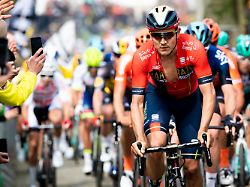Guessing about the reasons
Accumulated serious heart problems cause cycling scene
December 11, 2023, 12:07 p.m
This year alone, five professional cyclists had to end their careers with some serious heart problems. The case of Henrich Haussler, for example, causes great astonishment. There is no general explanation for the accumulation. But there is a suspicion.
The last months of Heinrich Haussler’s career sometimes leave you stunned. In late summer 2022, the professional cyclist fell ill with Covid-19, but still rode the Germany tour. After all, he wanted to be nominated for the World Cup in his native Australia. After that, he had heart problems almost every day in training. In the World Championship race, the arrhythmias occurred again, Haussler held on to the team car for two minutes – and completed the race.
Because the problems that had occurred for the first time in training in 2020 did not go away, his team ultimately gave him a break. A restart followed, but the heart didn’t cooperate. The team doctor ordered strict rest. “So I sat at home on the couch,” Haussler told the “Badische Zeitung”. “After a week I thought: I have to go for a casual run. What’s going to happen? Then I collapsed.” After collapsing while jogging, Haussler was fitted with a defibrillator. The diagnosis of ventricular tachycardia, a life-threatening arrhythmia, translated into: end of career. What is striking: Haussler is not an isolated case. At least four other professional cyclists had to end their careers this year due to heart problems.
Belgian Nathan Van Hooydonck, a helper in both of Jonas Vingegaard’s Tour de France victories, lost consciousness behind the wheel of his car in September. His pregnant girlfriend was sitting next to him. Both suffered only minor injuries; Van Hooydonck was diagnosed with a heart muscle anomaly. Dutchman Wesley Kreder suffered a heart attack in his sleep at the end of August but survived thanks to his wife’s quick intervention. A few days later, the Dane Niklas Eg got off his bike because he suddenly noticed his heart racing during training. This had already happened to Sep Vanmarcke; the Belgian had to retire at the beginning of July.
Don’t panic, but be very worried
There is no panic in the peloton, but there is a certain amount of concern. “Due to the publications, drivers have become more aware,” said Dr. Ortwin Schäfer. The Saarlander is the head doctor of the top German team Bora-hansgrohe and has been involved in cycling for many years. Among other things, he examines the question of whether professional cyclists who have been cycling under high intensity strain for years become more susceptible to cardiovascular diseases at a certain point. Specifically: Is a lot of exercise too much at some point?
It is not yet possible to give generally valid answers. Each case must be considered individually because the cardiovascular system is extremely complex and various parameters must be taken into account. These include, among other things, congenital heart disease, acute myocarditis, living conditions, medication and possible doping. What makes things even more difficult is the sometimes reserved communication. Not every driver shares his diagnosis like Haussler.
A comprehensive French study collected data from participants in the Tour de France between 1947 and 2012. Among the 786 participants, a 41 percent lower mortality rate was recorded compared to the male French population. “However, the results do not allow a judgment to be made about the balance between the positive effects of high-level physical activity and the potentially harmful effects of excessive physical activity or alleged doping,” the conclusion said.
Sport is the “best pill”
Schäfer emphasizes that exercise in general is the “best pill you can prescribe”. But he also asks himself a question that has arisen through observations in top-class sport, which he cannot answer at the moment: “Can overstressing of the cardiovascular system occur as a result of high-intensity exercise over a long period of time?”
There is at least evidence of it. Depending on the study, top athletes are described as having a two to ten times higher risk of atrial fibrillation than the general population and their coronary arteries are more likely to contain calcium. There are also increasing scarring changes in the heart muscle. The athletes who were recently forced to end their careers usually trained early on with high volumes and loads. “This is all the subject of current research,” said Schäfer. Sport is generally healthy, but “no one can say whether the curve will tip at some point.”
No exercise if you have a cold or Corona
When it comes to the early detection of heart problems, Schäfer believes the UCI is well positioned. Inflammation and stress levels are determined in blood tests four times a year. Before a season, every professional cyclist must undergo a comprehensive screening with a resting ECG and, alternating annually, a cardiac ultrasound and a stress ECG.
However, Schäfer criticizes the lack of definition as to how a cardiac ultrasound should be carried out. “You can measure a thousand things, but standards need to be set for what is important in sport,” said the doctor. In fact, not every edema or small scar on the heart can be found through screening. Schäfer therefore also carries out a strain analysis, a deformation analysis of the heart, on his athletes. He would like this to become mandatory.
In Haussler’s case, the reasons for his illness are still unclear. However, the 39-year-old, who is now the sporting director at Bora-hansgrohe, has learned for life – and would definitely like to pass on this experience. “Ending a competition with a cold or Corona. I am strictly against that,” said the 2009 Tour stage winner. Because there is still life afterward.
